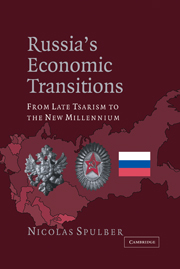Book contents
- Frontmatter
- Contents
- Figures and Tables
- Preface
- PART I THE TSARIST ECONOMIC TRANSITION
- 1 The Socioeconomic Framework
- 2 The Transition Issues
- 3 The Economic Policies
- 4 The Problems of Agriculture
- 5 The Industrial Changes
- 6 Domestic and Foreign Trade
- 7 Money and Banking
- 8 State Finance
- 9 Overall View
- PART II THE SOVIET ECONOMIC TRANSITION
- PART III THE POST-SOVIET ECONOMIC TRANSITION
- Index
4 - The Problems of Agriculture
Published online by Cambridge University Press: 03 December 2009
- Frontmatter
- Contents
- Figures and Tables
- Preface
- PART I THE TSARIST ECONOMIC TRANSITION
- 1 The Socioeconomic Framework
- 2 The Transition Issues
- 3 The Economic Policies
- 4 The Problems of Agriculture
- 5 The Industrial Changes
- 6 Domestic and Foreign Trade
- 7 Money and Banking
- 8 State Finance
- 9 Overall View
- PART II THE SOVIET ECONOMIC TRANSITION
- PART III THE POST-SOVIET ECONOMIC TRANSITION
- Index
Summary
Landholding
The abolition of serfdom created the preliminary conditions for changes in agriculture – eventually involving the diversification of outputs, the intensification of production, and the broadening of the market connections – along with deep permutations in the patterns of growth of population and its density in the various regions of the country. On the other hand, the agricultural reform's retention of the commune as the instrument of keeping the peasantry tied to the land, the acute scarcity of peasant land due to the expanding population, and the heavy burden of taxation and of the payments for the allotted lands generated increasing pressures of revolt and instability in the village and hampered rather than helped the desired modernization of agriculture.
As can be seen in Table 4-1, the total land surface of the Empire amounted to 1.952.2 million dessiatins, out of which European Russia accounted for 442.7 million. In the latter figure, agricultural utilization – in the broadest sense of the term (that is, including the forests) – accounted for 243.0 million dessiatins (close to 55 percent); in the Empire as a whole, the total agricultural utilization, as defined, amounted to only 25.7 percent.
With regard to the structure of landholding in European Russia, recall that the state and the Imperial family were stated to account in 1905 for 145.2 million dessiatins, and the peasants, on the allotted lands, for 136.2 million (refer to Table 1-4).
- Type
- Chapter
- Information
- Russia's Economic TransitionsFrom Late Tsarism to the New Millennium, pp. 73 - 84Publisher: Cambridge University PressPrint publication year: 2003



